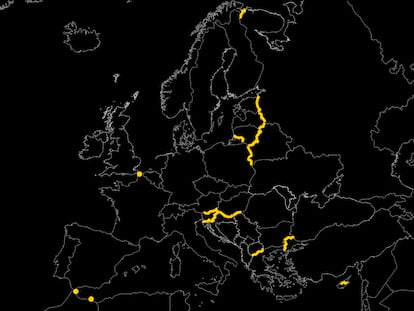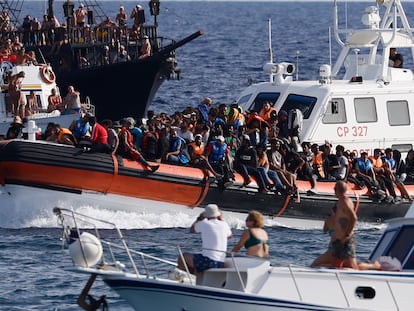The migratory tragedy in Europe: oil on canvas
Gonzalo Orquín — a Spanish artist based in Rome — portrays the migratory phenomenon through his realistic paintings, depicting the men and women who try to reach Europe by land and sea
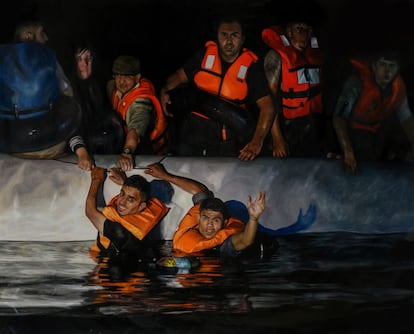
They didn’t know how to swim. In fact, they had never even looked at the sea. So, at three in the morning — when the human traffickers forced them to jump onto the rubber boat that would take them across the Mediterranean from Libya — the horizon that opened up seemed like an immense black hole, offering little hope of survival.
“The sea at night is too big,” one of the people told Gonzalo Orquín. The 41-year-old Spanish painter tried to contemplate the unfathomable horror. He decided to use that phrase as the subtitle of the exhibition Being Human, which opens on November 22 at the MigratieMuseumMigration (MMM) in Brussels. The words provide a narrative guide to the pictorial work about the human beings who attempt to reach Europe via some of its deadliest borders.
Orquín — a realist painter who has lived in Rome since 2004 — already dealt with other social themes before the migratory crisis. The portrait he did of Turkish transsexual activist Hande Kader — tortured and murdered after protests against the police in her country — was one of the last works he did until recently.
Addressing the drama of immigration was a very different project. Especially because his art was going to become a kind of reporting tool. It required him to be on the ground, traveling, interviewing the affected individuals and collecting stories in the manner of a special envoy.
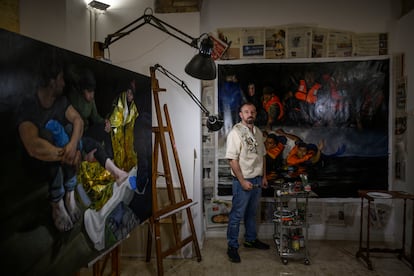
The project arose with journalist Francesca Paci, who has witnessed numerous international conflicts and is the curator of the exhibition. Years ago, she had already tried to take her artist friend on a trip to Syria, to portray the horror after the destruction of Aleppo at the hands of Bashar al-Assad’s army. But it was too complicated to work on the ground.
After a while, however, the nature of the human conflict that immigration represented once again united their paths. “Gonzalo’s painting — so hyper-realistic — works perfectly to narrate the present. He thought that the faces of migrants — often being treated as numbers — were going to have another presence through his work. That’s why I suggested doing portraits of the migrants. To tell their stories with the dignity of people who deserve a portrait, along with the time and work that it entails.”
The result is an experiment that also explores the boundaries of different disciplines. In this case, those of reporting and painting. “Art fixes the present in a dimension that slows it down, stopping it. And that seemed like it could work: this fusion of art and journalism enriches both worlds. Television and newspapers show snapshots of the moment… [but] the day after is something else. They’re superimposable photos, like the tragedies themselves. The present crushes everything that has happened before. Look what has happened now with the war between Israel and Palestine: Ukraine has disappeared [from the news]. One emergency usually covers up another. But bringing faces and scenes from these types of conflicts to a museum — moving them through other narrative places — gives them another dimension. They’re faces that remain fixed and cannot be superimposed on other news events,” Paci explains.
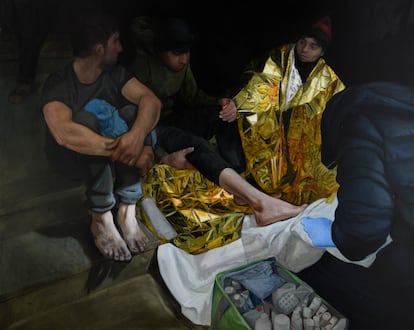
For weeks, the journalist and Orquín traveled along the northeastern border of Italy, which outlines the limits between Trieste and Slovenia – the place of passage for thousands of migrants, who walk the Balkan route to reach cities in northern Europe. Many of them cross Serbia, Croatia and Slovenia through forests, attempting to find an entrance to the European Union.
Orquín left his paintings in Rome and armed himself with a camera, which he used to document the entire process. He and Paci even recorded a short documentary that will be shown at the exhibition in Belgium. “That process was very difficult for me, because I’m not a reporter… it always felt like I was bothering people. But Francesca insisted that I be among them,” the painter recalls, in his studio in the Roman neighborhood of Porta Pia. “The result is an exhibition that seeks to honor the Spanish tradition of portraiture and realism, while seeking to give voice to those who are too often invisible. I tried to create a bridge of understanding and empathy that reminds us that, behind every migrant or refugee, there’s a unique and valuable story that deserves to be told and celebrated.”
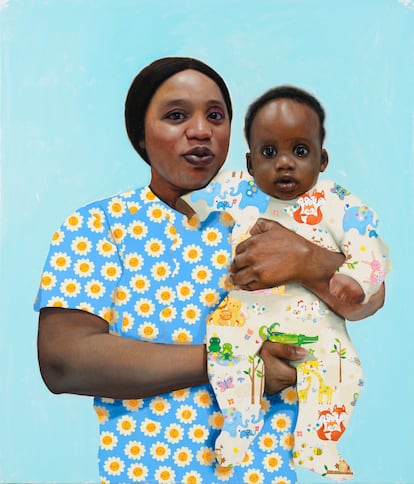
Orquín ultimately completed 16 paintings in this series, which make up the exhibit. Among them are portraits of men and women who managed to reach Italy through the forests. Many of the women were pregnant, racing to be able to give birth in a hospital and not in the middle of a road. The exhibition also explores the maritime side of the phenomenon, through the eyes of many other migrants who reached the EU through the island of Lampedusa, who gave their testimonies in one of Italy’s reception centers.
A huge painting now presides over Orquín’s studio and will travel this week to Brussels as a symbol of the exhibition. It’s the real scene of a rescue along the coast of the Greek island of Lesbos. The image, in this case, was taken by the photographer Francesco Malavolta, who gave it to the painter for his work. The artist depicts — in all its crudeness — another type of border… one that blurredly separates life and death during a migrant’s journey en route to Europe.
Sign up for our weekly newsletter to get more English-language news coverage from EL PAÍS USA Edition
Tu suscripción se está usando en otro dispositivo
¿Quieres añadir otro usuario a tu suscripción?
Si continúas leyendo en este dispositivo, no se podrá leer en el otro.
FlechaTu suscripción se está usando en otro dispositivo y solo puedes acceder a EL PAÍS desde un dispositivo a la vez.
Si quieres compartir tu cuenta, cambia tu suscripción a la modalidad Premium, así podrás añadir otro usuario. Cada uno accederá con su propia cuenta de email, lo que os permitirá personalizar vuestra experiencia en EL PAÍS.
¿Tienes una suscripción de empresa? Accede aquí para contratar más cuentas.
En el caso de no saber quién está usando tu cuenta, te recomendamos cambiar tu contraseña aquí.
Si decides continuar compartiendo tu cuenta, este mensaje se mostrará en tu dispositivo y en el de la otra persona que está usando tu cuenta de forma indefinida, afectando a tu experiencia de lectura. Puedes consultar aquí los términos y condiciones de la suscripción digital.
More information
Archived In
Últimas noticias
Most viewed
- Reinhard Genzel, Nobel laureate in physics: ‘One-minute videos will never give you the truth’
- Oona Chaplin: ‘I told James Cameron that I was living in a treehouse and starting a permaculture project with a friend’
- Pablo Escobar’s hippos: A serious environmental problem, 40 years on
- Why we lost the habit of sleeping in two segments and how that changed our sense of time
- Charles Dubouloz, mountaineering star, retires at 36 with a farewell tour inspired by Walter Bonatti

